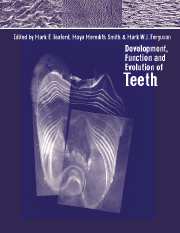Book contents
- Frontmatter
- Contents
- List of contributors
- Acknowledgements
- Part one Genes, molecules and tooth initiation
- Part two Tooth tissues: development and evolution
- Part three Evolution of tooth shape and dentition
- 10 Evolutionary origins of teeth and jaws: developmental models and phylogenetic patterns
- 11 Development and evolution of dentition patterns and their genetic basis
- 12 Evolution of tooth attachment in lower vertebrates to tetrapods
- 13 Tooth replacement patterns in non-mammalian vertebrates
- 14 The evolution of tooth shape and tooth function in primates
- 15 ‘Schultz's Rule’ and the evolution of tooth emergence and replacement patterns in primates and ungulates
- Part four Macrostructure and function
- Index
11 - Development and evolution of dentition patterns and their genetic basis
Published online by Cambridge University Press: 11 September 2009
- Frontmatter
- Contents
- List of contributors
- Acknowledgements
- Part one Genes, molecules and tooth initiation
- Part two Tooth tissues: development and evolution
- Part three Evolution of tooth shape and dentition
- 10 Evolutionary origins of teeth and jaws: developmental models and phylogenetic patterns
- 11 Development and evolution of dentition patterns and their genetic basis
- 12 Evolution of tooth attachment in lower vertebrates to tetrapods
- 13 Tooth replacement patterns in non-mammalian vertebrates
- 14 The evolution of tooth shape and tooth function in primates
- 15 ‘Schultz's Rule’ and the evolution of tooth emergence and replacement patterns in primates and ungulates
- Part four Macrostructure and function
- Index
Summary
Introduction
A fundamental question in developmental biology is how patterns are established, and in evolutionary biology how patterns are changed. The pattern of vertebrate dentitions (tooth morphology, number, and location) is of obvious importance to the survival of individual organisms and a great diversity of patterns exists among vertebrate taxa (Peyer, 1968). Furthermore, the abundance of teeth and jaws in the fossil record provides a tremendous amount of information about the evolutionary changes that have occurred in these patterns. However, despite the accumulation of histological and molecular information on the development of individual teeth (Thesleff et al., 1996; Ruch, 1987), little is known about the control of the pattern of the dentition as a whole during embryonic development. Such information is crucial for understanding the mechanisms of evolutionary change in the vertebrate dentition. In this chapter, we review aspects of the evolution of dentition patterns, models that have been proposed for the developmental mechanisms responsible for these patterns and candidate genes for controlling them. Although the dentitions of mammals constitute only a small portion of the diversity observed in vertebrates, we will concentrate on this group because of the much greater availability of developmental and genetic data. For the purposes of this chapter, ‘dentition pattern’ refers to the number, location, and arrangement of differently shaped teeth, while ‘dental pattern’ is used to describe the crown structure of individual teeth, e.g. location, shape and size of cusps.
Axial definitions for the adult dentition and embryonic jaws
Various axial definitions for the adult dentition and embryonic mandible have been used in the literature (Table 11.1). However, these definitions can be inconsistent or confusing.
- Type
- Chapter
- Information
- Development, Function and Evolution of Teeth , pp. 152 - 172Publisher: Cambridge University PressPrint publication year: 2000
- 23
- Cited by



